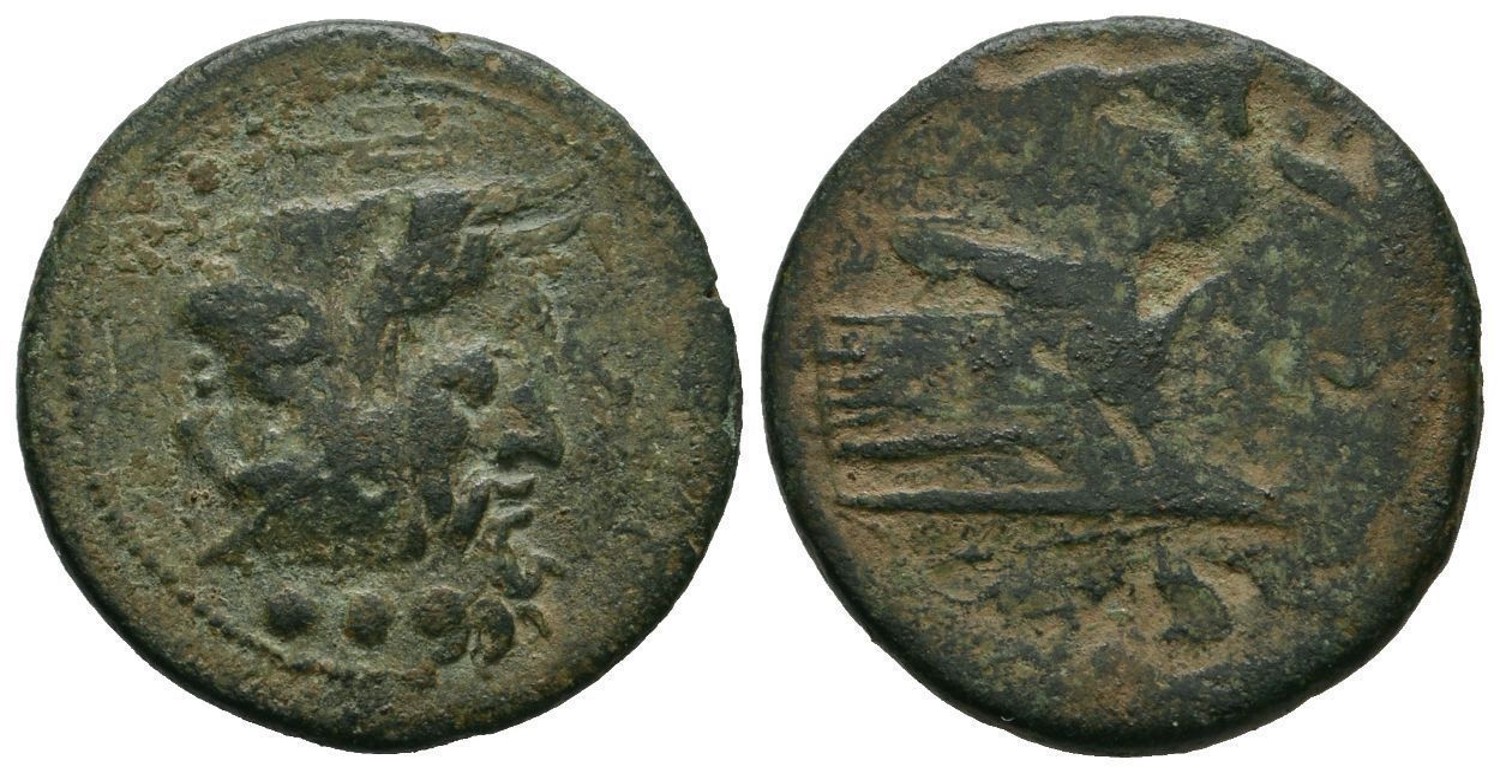3264 - Canusium (Roman Republic) (AE Minerva/prow) over Oiniadae (Zeus/Achelous) (Ebay Numismatik Lanz, 6 May 2017 - Witschonke coll.)
From SILVER
(Redirected from 3264 (Ebay.de seller Numismatik Lanz, 06 May 2017))
209 BCE - 208 BCE | ROMA
Images
Overstruck variety

Ref zeus acheloos.png [1]
Location/history
| Sale(s)Sale(s) ᵖ: | Ebay.de NumismatikLanz, 6 May 2017 | |
| Private collection(s)Private collection(s) ᵖ: | Rick B. Witschonke coll. |
Overstriking coin
Description
| ObverseInscription or printing placed on the obverse.: | Head of Minerva right, wearing necklace, earing and crested Corinthian helmet. Above, 4 pellets (mark of value). Below, CA (?) Border of dots. | ReverseInscription or printing placed on the reverse.: | ROMA (Latin) Prow of galley right. In right field, CA. Below, 4 pellets (mark of value). Linear border. |
Mint and issuing power
| MintIdentifies the place of manufacture or issue of a numismatic object.: | Canusium | Ancient regionAncient region. | Apulia | Modern countryModern country: Italy | AuthorityIdentifies the issuing power. The authority can be "pretended" when the name or the portrait of X is on the coin but he/she was not the issuing power. It can also be "uncertain" when there is no mention of X on the coin but he/she was the issuing power according to the historical sources: | Roman Republic |
Chronology
| FromIdentifies the initial date in a range assigned in a numismatic context. 209 BCE toIdentifies the final date in a range assigned in a numismatic context.. 208 BCE | Hellenistic 323-30 BC |
Physical description
| MetalThe physical material (usually metal) from which an object is made.: Bronze |
WeightWeight of the numismatic object (in grams). in grams: 5.385.38 g <br />5,380 mg <br /> | DenominationTerm indicating the value of a numismatic object. Examples: tetradrachm, chalkous, denarius.: triens |
|
| DiameterDescribes diameter of an object (in mm).: 2424 mm <br />2.4 cm <br /> | StandardStandard.: uncia | ||
References
| Coin referenceReference of the Coin: | Coin series referenceReference to coin series study: | Sydenham 19521Sydenham 1952, n° 309c., RRC2RRC, n° 100/3 | |
| Coin series web referenceCoin series web references: | |||
Overstruck type
Description
| ObverseInscription or printing placed on the obverse.: | Head of Zeus right | ReverseInscription or printing placed on the reverse.: | OINIAΔAN (Greek) Head of river-god Acheloüs right |
Mint and issuing power
| MintIdentifies the place of manufacture or issue of a numismatic object. ᵖ: | Oiniadae | Ancient regionAncient region. ᵖ | Acarnania | Modern countryModern country: Greece | AuthorityIdentifies the authority in whose name (explicitly or implicitly) a numismatic object was issued. ᵖ: |
Chronology
| FromIdentifies the initial date in a range assigned in a numismatic context. 219 BCE toIdentifies the final date in a range assigned in a numismatic context.. 211 BCE | Hellenistic 323-30 BC |
Physical description
References
| Coin type referenceReference to coin series study ᵖ: | BMC Thessaly3BMC Thessaly, Oeniadae, n° 6-14, BCD Akarnanien und Aetolien4BCD Akarnanien und Aetolien, n° 351.1-11, HGC 45HGC 4, n° 899 | ||
| Coin series web reference overstruckCoin series web references overstruck: | |||
Additional data
| Frequency of overstrikesFrequency of overstrikes: | frequent | Level of confidenceLevel of confidence of the identification: | sure |
| RemarksRemarks: | "Overstruck on an Akarnanian League Chalkous (see: SNG Copenhagen 421)" | ||
References
- ^ Sydenham, Edward Allen (1952), The Coinage of the Roman Republic, London, Spink & Son Ltd., lxix, 343 p., 30 pl.
- ^ Crawford, Michael H. (1974), Roman Republican Coinage, Cambridge
- ^ Gardner, Percy (1883), A Catalogue of the Greek coins in the British Museum. vol. V : Thessaly to Aetolia, London, The Trustees, p. 234, pl. 32.
- ^ Münzen & Medaillen (Deutschland). Sammlung BCD : Akarnanien und Aetolien. Auction 23, 18 October 2007, Stuttgart, 591 lots.
- ^ Hoover, Oliver D. (2014), Handbook of Greek Coinage Series 4. Northern and Central Greece : Achaia Phthiotis, Ainis, Magnesia, Malis, Oita, Perrhaibia, Thessaly, Akarnania, Aitolia, Lokris, Phokis, Boiotia, Euboia, Attica, Megaris and Corinthia, sixth to first centuries BC, Lancaster, lxxi, 563 p.
